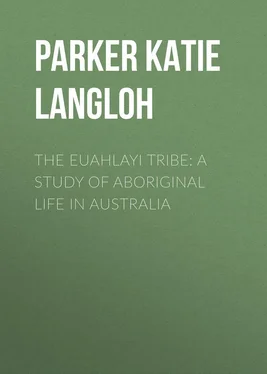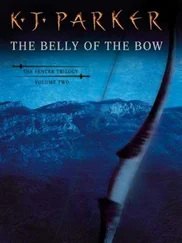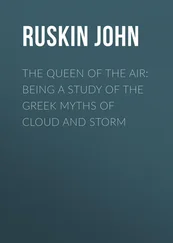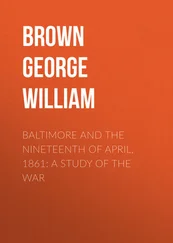Katie Parker - The Euahlayi Tribe - A Study of Aboriginal Life in Australia
Здесь есть возможность читать онлайн «Katie Parker - The Euahlayi Tribe - A Study of Aboriginal Life in Australia» — ознакомительный отрывок электронной книги совершенно бесплатно, а после прочтения отрывка купить полную версию. В некоторых случаях можно слушать аудио, скачать через торрент в формате fb2 и присутствует краткое содержание. Жанр: foreign_antique, foreign_prose, на английском языке. Описание произведения, (предисловие) а так же отзывы посетителей доступны на портале библиотеки ЛибКат.
- Название:The Euahlayi Tribe: A Study of Aboriginal Life in Australia
- Автор:
- Жанр:
- Год:неизвестен
- ISBN:нет данных
- Рейтинг книги:5 / 5. Голосов: 1
-
Избранное:Добавить в избранное
- Отзывы:
-
Ваша оценка:
- 100
- 1
- 2
- 3
- 4
- 5
The Euahlayi Tribe: A Study of Aboriginal Life in Australia: краткое содержание, описание и аннотация
Предлагаем к чтению аннотацию, описание, краткое содержание или предисловие (зависит от того, что написал сам автор книги «The Euahlayi Tribe: A Study of Aboriginal Life in Australia»). Если вы не нашли необходимую информацию о книге — напишите в комментариях, мы постараемся отыскать её.
The Euahlayi Tribe: A Study of Aboriginal Life in Australia — читать онлайн ознакомительный отрывок
Ниже представлен текст книги, разбитый по страницам. Система сохранения места последней прочитанной страницы, позволяет с удобством читать онлайн бесплатно книгу «The Euahlayi Tribe: A Study of Aboriginal Life in Australia», без необходимости каждый раз заново искать на чём Вы остановились. Поставьте закладку, и сможете в любой момент перейти на страницу, на которой закончили чтение.
Интервал:
Закладка:
Certainly woman is given a high place in their sacred lore. The chief wife of Byamee, Birrahgnooloo, is claimed as the mother of all, for she, like him, had a totem for each part of her body; no one totem can claim her, but all do.
Mother of all, though mother of none in particular, she was not to be vulgarised by ordinary domestic relations, For those purposes Cunnumbeillee was at hand, as a bearer of children and a caterer. Yet it was Birrahgnooloo whom Byamee best loved and made his companion, giving her power and position which no other held. She too, like him, is partially crystallised in the sky-camp, where they are together; the upper parts of their bodies are as on earth; to her, those who want floods go, and when willing to grant their requests, she bids Cunnumbeillee start the flood-ball of flood rolling down the mountains. Cunnumbeillee, as has been said, had but one totem which her children derived from her.
Byamee is the originator of things less archaic and important than totemism. There is a large stone fish-trap at Brewarrina, on the Barwan River. It is said to have been made by Byamee and his gigantic sons, just as later Greece attributed the walls of Tiryns to the Cyclops, or as Glasgow Cathedral has been explained in legend as the work of the Picts. Byamee also established the rule that there should be a common camping-ground for the various tribes, where, during the fishing festival, peace should be strictly kept, all meeting to enjoy the fish, and do their share towards preserving the fisheries.
Byamee still exists. I have been told by an old native, as will be shown later, that prayers for the souls of the dead used to be addressed to Byamee at funerals; certainly not a practice derived from Protestant missionaries.
Byamee is supposed to listen to the cry of an orphan for rain. Such an one has but to run out when the clouds are overhead, and, looking at the sky, call aloud
'Gullee boorboor. Gullee boorboor.'
'Water come down. Water come down.'
Or should it be raining too much, the last possible child of a woman can stop it by burning Midjeer wood.
Bootha told me after one rain that she had sent one of her tutelary spirits to tell Boyjerh – Byamee is called by women and children Boyjerh – that the country wanted rain. In answer he had taken up a handful of crystal pebbles and thrown them from the sky down into the water in a stone basin on the top of the sacred mountain; as the pebbles fell in, the water splashed up into the clouds above, whence it descended as the desired rain.
It is told to me, that at some initiatory rites the oldest medicine man, or Wirreenun, present addresses a prayer to Byamee, asking him to give them long life, as they have kept his law.
The tribesmen do not profess to pray, or to have prayed, to Byamee on any occasions except at funerals, and at the conclusion of the Boorah.
As for Byamee's relation to ethics, it will be stated in the chapter on the tribal ceremonies, while the stories as to the rewards and punishments of the future life will be given in their place. Baiame's troubles with a kind of disobedient deputy, Darramulun, will also be narrated: the myth is current, too, among the Wir djuri tribe.
Other particulars about Byamee will occur in the course of later chapters: here I have tried to give a general summary of the native beliefs. The reader may interpret them in his own fashion, and may decide as to whether the beliefs do or do not indicate a kind of 'religion,' whether 'a recognised religion' or not. There is necessarily, of course, an absence of temples and of priests, and I have found no trace or vestige of sacrifice. What may be said on the affirmative side as to the religious aspect of the belief, the reader can supply from the summary of facts. Other potent beings occur in native myth, as we shall show, but there appears to exist between them and mankind no relation of affection, reverence, or duty, as in the case of Byamee.
Here it seems necessary to advert to a remark of Mr. Howitt's which appears to be erroneous. He says 'that part of Australia which I have indicated as the habitat of that belief' (namely, in an All Father),' is also the area where there has been the advance from group marriage to individual marriage; from descent in the female line to that in the male line; where the primitive organisation under the class system has been more or less replaced by an organisation based on locality; in fact, where these advances have been made to which I have more than once drawn attention.'[Howitt, NATIVE TRIBES OF SOUTH-EAST AUSTRALIA, p. 500.]
Mr. Howitt forgets that he himself attributes the early system of descent through women, and also the belief in an All Father (Nurelli), to the Wiimbaio tribe [IBID. p. 489] to the Wotjobaluk tribe,[NATIVE TRIBES OF SOUTH-EAST AUSTRALIA, pp. 120, 490.] to the Kamilaroi, to the Ta-Ta-thi,[IBID. p. 494] while female descent and the belief in Baiame mark the Euahlayi and Wir djuri. [JOURNAL, ANTHROPOLOGICAL INSTITUTE, XXV., p. 297.]
These tribes cover an enormous area of country, and, though they have not advanced to male kinship, they all possess the belief in an All Father. That belief does not appear to be in any way associated with advance in social organisation, for Messrs. Spencer and Gillen cannot find a trace of it in more than one of the central and northern tribes, which have male kinship, and a kind of local self-government. On the other hand, it does occur among southern tribes, like the Kurnai, which have advanced almost altogether out of totemism.
In short, we have tribes with female descent, such as the Dieri and Urabunna, to whom all knowledge of an All Father is denied. We have many large and important tribes with female descent who certainly believe in an All Father. We have tribes of the highest social advancement who are said to show no vestige of the belief, and we have tribes also socially advanced who hold the belief with great vigour. In these circumstances, authenticated by Mr. Howitt himself, it is impossible to accept the theory that belief in an All Father is only reached in the course of such advance to a higher social organisation as is made by tribes who reckon descent in the male line.
CHAPTER III
RELATIONSHIPS AND TOTEMS
Some savants question the intellectual ability of the blacks because they have not elaborate systems of numeration and notation, which in their life were quite unneeded. Such as were needed were supplied. They are often incorporate in one word-noun and qualifying numerical adjective, as for example —
Gundooee A SOLITARY EMU
Booloowah TWO EMUS
Oogle oogle FOUR EMUS
Gayyahnai FIVE OR SIX EMUS
Gonurrun FOURTEEN OR FIFTEEN EMUS.
I fancy the brains that could have elaborated their marriage rules were capable of workaday arithmetic if necessary, and few indeed of us know our family trees as the blacks know theirs.
Even the smallest black child who can talk seems full of knowledge as to all his relations, animate and inanimate, the marriage taboos, and the rest of their complicated system.
The first division among this tribe is a blood distinction (I phratries'): —
Gwaigulleeah LIGHT BLOODED
Gwaimudthen DARK BLOODED.
This distinction is not confined to the human beings of the tribe, who must be of one or the other, but there are the Gwaigulleeah and Gwaimudthen divisions in all things. The first and chief division in our tribe, as regards customary marriage law, is the partition of all tribes-folk into these 'phratries,' or 'exogamous moieties.' While in most Australian tribes the meanings of the names of phratries are lost, where the meanings are known they are usually names of animals – Eagle, Hawk, and Crow, White Cockatoo and Black Cockatoo, and so forth. Among the great Kamilaroi tribe, akin in speech to the Euahlayi, the names of phratries, DILBI and KUPATHIN, are of unknown significance. The Euahlayi names, we have seen, are Gwaigulleeah, Light blooded, and Gwaimudthen, Dark blooded.
Читать дальшеИнтервал:
Закладка:
Похожие книги на «The Euahlayi Tribe: A Study of Aboriginal Life in Australia»
Представляем Вашему вниманию похожие книги на «The Euahlayi Tribe: A Study of Aboriginal Life in Australia» списком для выбора. Мы отобрали схожую по названию и смыслу литературу в надежде предоставить читателям больше вариантов отыскать новые, интересные, ещё непрочитанные произведения.
Обсуждение, отзывы о книге «The Euahlayi Tribe: A Study of Aboriginal Life in Australia» и просто собственные мнения читателей. Оставьте ваши комментарии, напишите, что Вы думаете о произведении, его смысле или главных героях. Укажите что конкретно понравилось, а что нет, и почему Вы так считаете.












